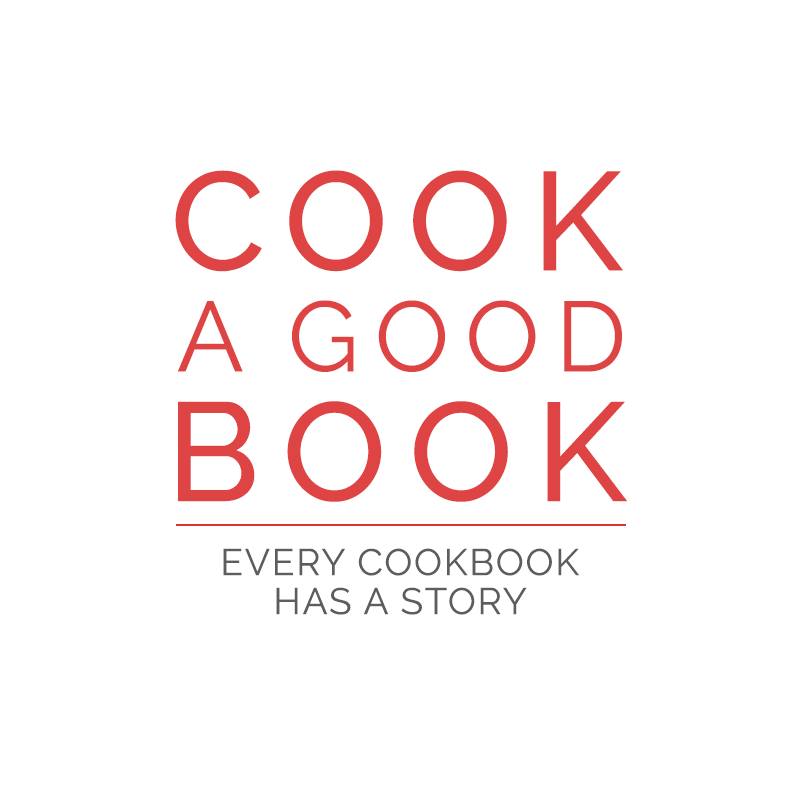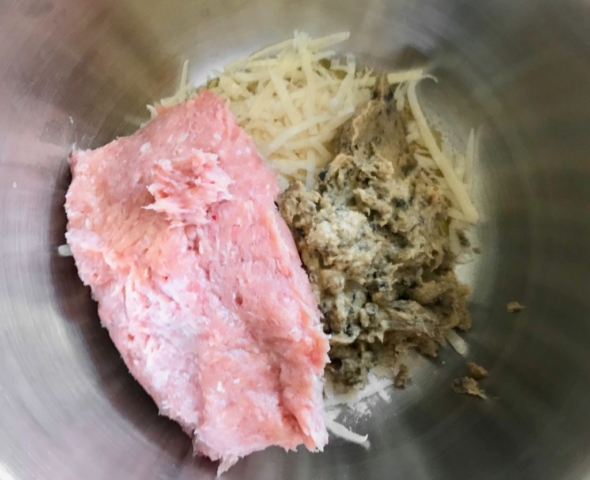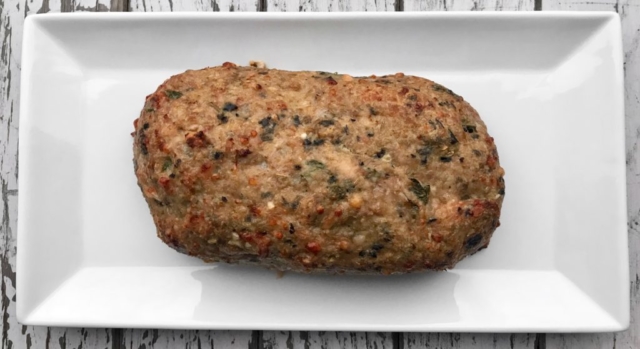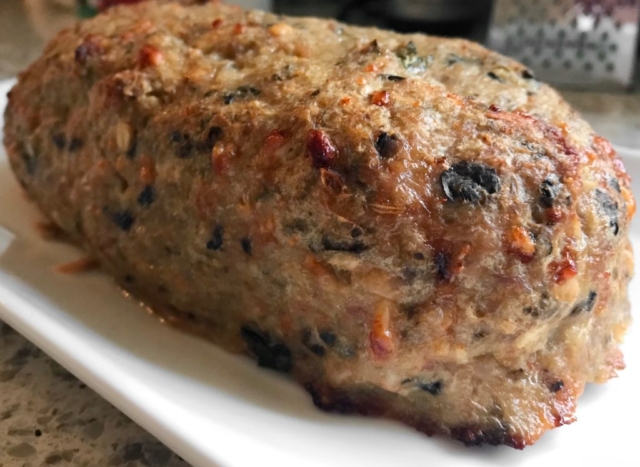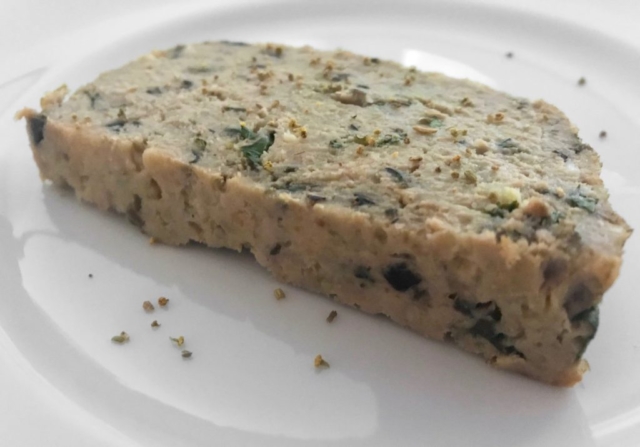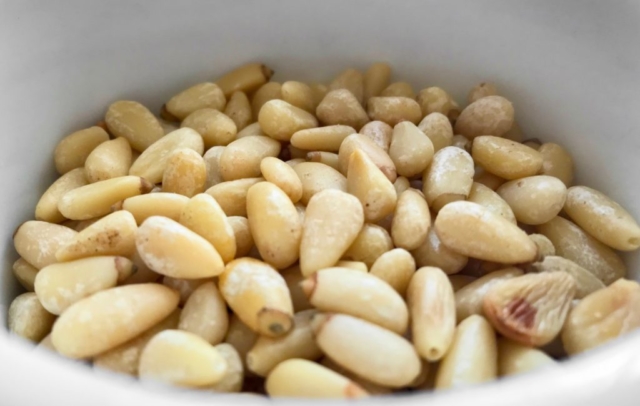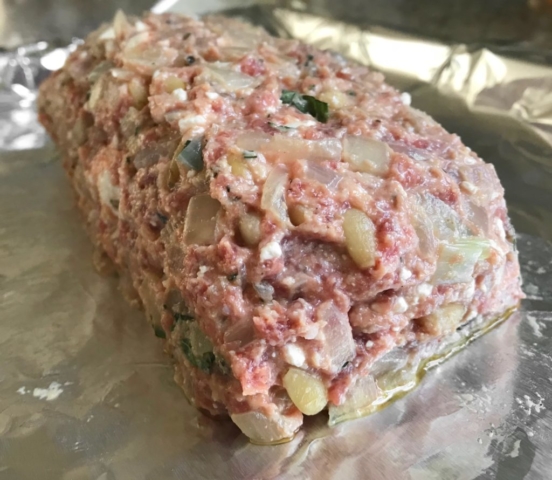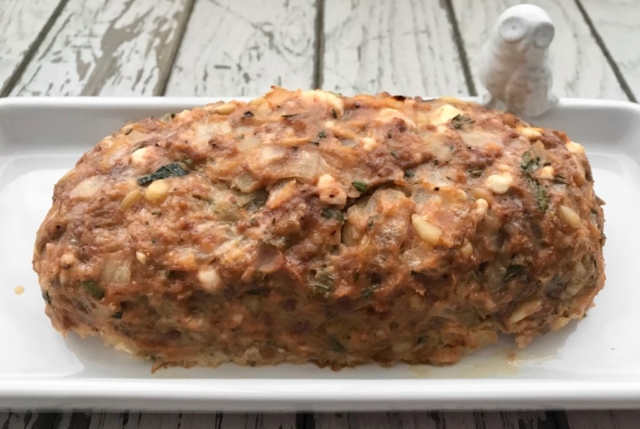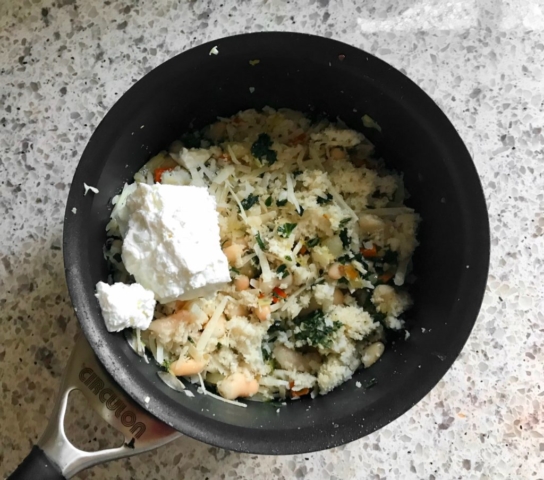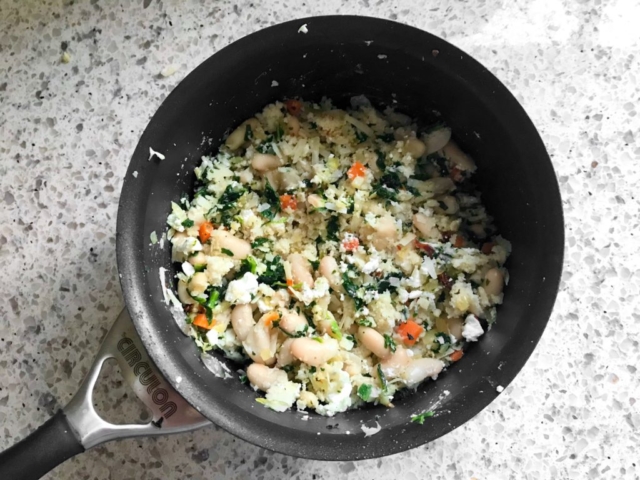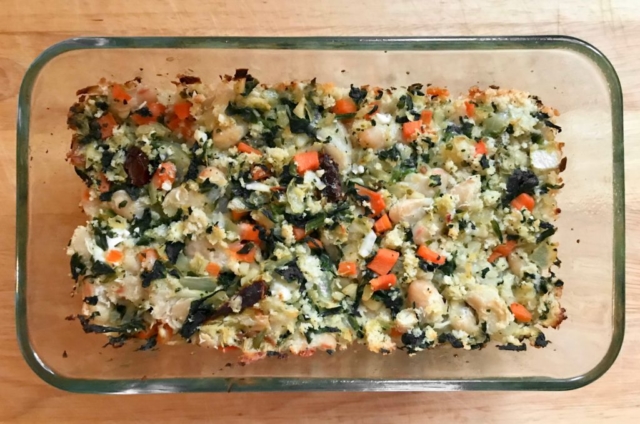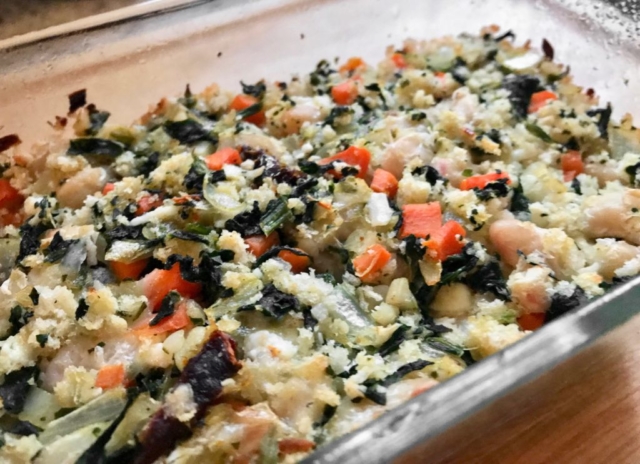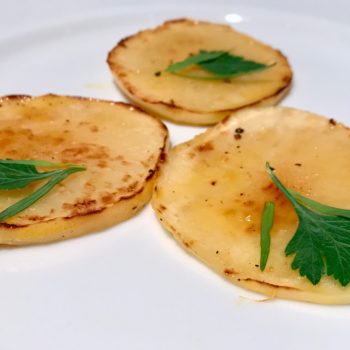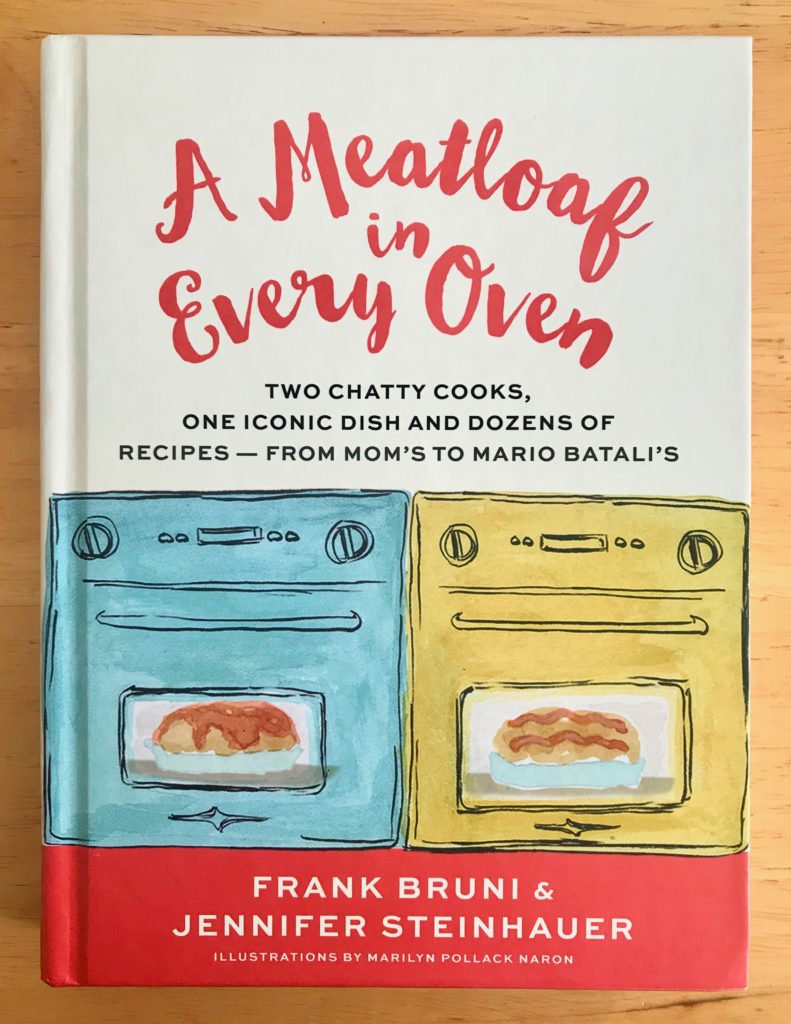
A Meatloaf in Every Oven
Frank Bruni and Jennifer Steinhauer
Illustrations by Marilyn Pollack Naron
2017
Purchased at Eataly New York Flatiron
Recipes cooked: Michael White’s chicken eggplant loaf, Greek loaf with lamb and feta, a meatless loaf for Dennis, Alex Guarnaschelli’s Mom’s meatloaf, Swedish meatball loaf
Recipes I want to cook: Annie Miler’s home-style loaf with cheddar and parsley, South African bobotie loaf, Daniel Patterson’s zucchini loaf, Auvergne style loaf with prunes, Leslie Bruni’s sweet nostalgic loaf
Difficulty to make: Easy
Difficulty to source: Easy to medium
Chef Michael White’s chicken and eggplant loaf
“I don’t even know where I am right now,” I thought as I savored each tiny bite from a cold, three day old slice of chicken and eggplant meatloaf. It had fennel seeds in it, enticing me to sprinkle fennel pollen over it like fairy dust. This particular meatloaf was one of the best things I, and my husband, had ever eaten—so while it should come as no surprise that someone as famously talented as chef Michael White created it, it still comes as a surprise that someone as famously talented as chef Michael White created it. Here was our earnest, lovestruck, handsome prince, with the Cinderella of foods. The meatloaf tasted milky, savory, and quintessentially Italian, like the best sausage you’ve never had. Knowing what I did to make it made the resulting loaf nothing short of sorcery, because the impossibly smooth texture came from two tablespoons of cream for more than a pound of meat. To quote Olympic figure skater Adam Rippon, I can’t explain witchcraft.
I bought this book because—honestly?—I have an impossible crush on Frank Bruni, the best New York Times restaurant critic ever to happen to the publication (and here I also want to recognize Sam Sifton as its most brilliant food editor, truly). I met Frank once, at a book tour stop in New York almost ten years ago, and he recognized me from waiting tables in Midtown Manhattan. Ladies and gentlemen, you will not meet a more handsome, affable, and unpretentiously smart man than him and also my husband. (I’m trying very hard to be a good wife here, and I don’t know if it’s working.)
So, I was perusing the cookbook section in New York’s Flatiron Eataly on a mini-vacay with my mom last May and spotted his name on this cookbook. It was so fitting. My mom, a former dietician, has been supporting radish, alfalfa, and bulgar wheat farmers everywhere since the seventies, and the margarine industry hinges on her every loaf of oatmeal banana bread. She’s a resourceful home cook, in that she can—and will—substitute anything for the fat a recipe calls for, and she never wastes food. She would never call herself “granola.” But granola is something she would add to meatloaf. She’s made a lot of meatloaf.
Growing up, I mostly liked my mom’s meatloafs. No two loafs were ever the same, though, as she added whatever expiring vegetables, meats, grains, herbs, and even condiments could be absorbed into lean ground turkey, egg whites, and skim milk. Her meatloafs were the ultimate regiftings, of crusty lidded, half empty jars of grocery store salsa.
Around the same time that I met Frank in 2009—yes, I am acting like I am on a first name basis with him—he awarded one star to a Brooklyn restaurant called Rye, which had made a name for itself for its meatloaf sandwich; happily, it is still humming along and the meatloaf is still on the menu, perhaps because Frank’s review had much good to say about the meatloaf (if relatively little besides). I brought my mom to Rye soon after the review on one of her frequent visits to see New York me, and she liked it, though she thought the long subway ride and walk through the surrounding neighborhood at the time were not really worth it. But as this cookbook will tell you, “meatloaf is metaphor: it’s life made loaf.” My mom knew, then and there, that her daughter had grown up, moved away to a big city, and discovered a world of meatloaf potential. I was 25 and loafing at life but living it up. When I wasn’t buying so many fourteen-dollar glasses of wine I would finally get locked inside of bars and drink for free with my best friend after 4 a.m. (the pot of gold at the end of the white, rosé, and red rainbow), meatloaf was one of the few foods I could afford to make and fit into my tiny oven at my 29th and Lex walk-up.
And now I’m getting emotional, and I’m not sure if it’s because I’m sentimental about my twenties or if it’s because there are only around three slices left of Michael White’s chicken and eggplant meatloaf in my refrigerator, with its glistening ribbons of Parmigiano-Reggiano and pine colored basil leaves.
So about this cookbook. It’s half book, half cookbook, with half the cover size of most cookbooks. In lieu of photography, it’s illustrated with sassy watercolor and ink art, which I loved—I took so many photos of these meatloafs and deleted nearly all of them because this just isn’t your pretty pretty princess of foods. And this is a cookbook by writers for readers. It’s so delightful to read, especially if you have some attachment to either Frank or his brilliant, funny, knowledgeable of all things loaf co-author, Jennifer Steinhauer, who has covered all things Congress for the New York Times since 2010. Each of the eight chapters (classics plus variations like global and meatless) opens with a dialog between the authors, inviting the reader to be in on their inside jokes about mint jelly, sleeping pills, Catholicism, facial moisturizer, and “all things Italian.”
Sometimes, I fear that my friends and family who claim to love their Blue Apron subscriptions and Instapots and Food Network reruns are kind of white-knuckling it through the home cooking trend. Going to the grocery store, standing over aromatics at my stove, and reading cookbooks like novels are the best parts of my week, besides the eating, and still, I can see how it all got to be so joyless. Entire news stories have been done on the parking lot situations at Los Angeles’ grocery stores. But I also wonder, what if every cookbook had a discussion of the mutton episode of Seinfeld (page 92), a philosophy on the “cheeseburger writ large, a cheeseburger in extremis” (page 180), or a tease of NYT newsroom gossip (page 147), and its recipes were easy and fun to make and turned out perfect one-pan meals?
If there’s one flaw, it’s that it could use more of the NYT newsroom gossip. I hope they’re just saving it for the sequel. A Meatloaf in Every Freezer, maybe. Except, none of the meatloafs I made, which I planned for us to eat some of then save, ever met a frozen fate. My husband and I snuck into the refrigerator all day and carved little bites off, not even leaving enough behind for the dog to lick off the plates.
Greek loaf with lamb and feta
Back to the book. Reading the introduction is essential. You will learn that most of the meatloafs are meant to be shaped by hand and cooked on a rimmed baking sheet rather than in a loaf pan, that meatloafs love a lot of seasoning, that meatloafs are all at once global and historic and sustainable, that “cheese is your ally” (page 15), and that, above all else, “ don’t be afraid of anything. Remember: meatloaf is magnanimous, and it’s supposed to be fun” (page 16).
To that end, I recommend that you blare oldies music and sing off-key and dance while you cook. I also stand by the real recommendations laid out in the introduction that you adhere to the ratio of meat to binder, that you buy meat with a decent amount of fat, and also that you use a good digital meat thermometer. Most recipes, but not all, call for a combination of ground meat, eggs, white bread soaked in milk or cream, bread crumbs or panko, onions, garlic, or herbs. (Worcestershire sauce and ketchup make a lot of appearances, too.) As Frank and Jenn will tell you, and I already knew from literally every meatloaf from my childhood, lean meat leans dry and bland, so you will need to add more of the ingredients that give you moisture and flavor if you insist on using it. Most of the recipes provide the internal temperatures for medium or well done, and using a thermometer will produce reliably moist meatloafs. The writers really seem to have it out for raw onion, though, so you will be slicing, dicing, and sautéeing for ten minutes before starting most recipes. I never made a recipe in its full quantity, instead dividing by two or three, and everything worked out really well thanks to the prioritization of internal temperature over cooking time, and it also turned out to be a lot of food nonetheless. A full recipe can feed a single person for a week. If only I’d had this when I was 25 in New York.
Another of their recommendations that I love is to mix with your hands. (Otherwise, as they put it, “you’d need some kind of magical spoon and some kind of magical strength.”) My tips? Wear short sleeves so you’re not doing the totally futile tug with your teeth when your pulled-up long sleeves inevitably fall down to your wrists. If you’re squeamish, buy disposable latex (or similar) gloves from your local neighborhood pharmacy for the mixing—they’re cheap and great for cleaning your place anyway. Put your prepared baking pan or loaf pan and any other mise dishes next to your mixing bowl before you get your hands in there, unless you love washing your hands A LOT.
“A meatless loaf for Dennis” minus tomato paste, because I forgot—it happens!
It helps, too, that the cookbook does not ask you to spend a lot of money on ingredients, though I always hope people will buy the most sustainably raised meat they can afford. It’ll be ten or twelve dollars for the meat, four dollars for this, a dollar for that, three dollars here and there, and that’s kind of it. Most of the ingredients are in my kitchen at any given time, and probably yours—to make April Bloomfield’s lamb loaf with yogurt and mint (page 96) right now, I’d only need to buy ground lamb, a can of tomatoes, and one of those tiny little single serving cups of Greek style yogurt. This is one of the fancier recipes. The Greek loaf with lamb and feta from the same chapter (page 93) might have been an expensive loaf to make if not for the huge bag of pine nuts from Costco that I already have in my refrigerator, begging for more uses. (Ditto for the tomato paste languishing in the butter compartment on my refrigerator door with an old “rejuvenating” eye gel, ever envious of my frequently replaced tubes of anchovy paste.) And if you mostly keep around things like Fritos, canned beans, cheese, eggs, and meat, there’s a Frito pie loaf for that (page 195). Apparently, it’s amazing.
One thing that is in my kitchen but probably isn’t in yours is a hand-crank meat grinder. It was with this cookbook in mind that I asked for one for Christmas and received it. It’s compact, dishwasher safe, and a tiny fraction of the price of an electric grinder. Wrote Jenn on page 92:
The chefs featured here would also prefer that home cooks grind their own meat. We have a more realistic view of the world, and understand that our readers have jobs and children and Amazon carts that need pruning and crazy eye doctors who keep sending the same bill over and over again.
After a first failed attempt with my grinder (redeemed by an improvised Italian red sauce braise for all that fresh chuck and pork shoulder) I realized I’d assembled it wrong. I then made Alex Guarnaschelli’s Mom’s meatloaf recipe (page 45) and the Swedish meatball loaf (page 77), with hand-ground meat. The texture—the chew—is astonishing, exciting, and so well worth the small effort. It really is. It also saves money in the long term—ground beef and pork at Whole Foods are both $8 per pound, whereas chuck is $4 per pound, and pork shoulder is $2 per pound, give or take a buck.
I know, I can’t make you (poof!) buy this cookbook. I wish I could. I made the vegetarian loaf with beans because I hate beans—it was the first time I ever cooked beans, truly, ever—and I liked it. The banter is hilarious, the kind of writing that made me want to read in bed instead of watch TV at night. There are even game meat recipes from Paul Ryan and Nancy Pelosi. There is simply nothing not to like. One thing I can do, though, is finally stop talking about it, so you can, you know, if you want, go buy this cookbook. And you will live happily ever after.
